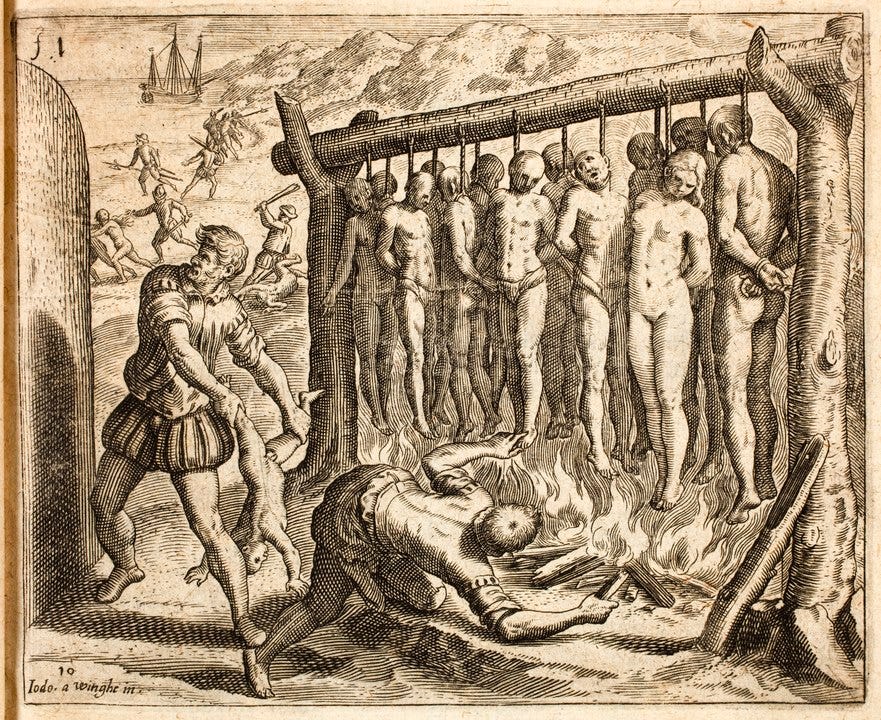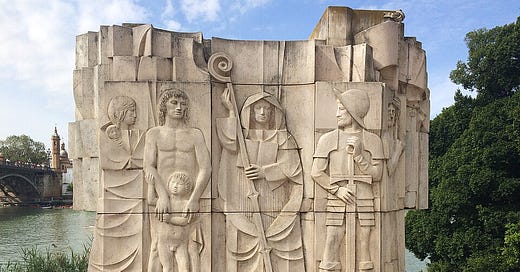The Spanish came like starving wolves, tigers, and lions, and for four decades have done nothing other than commit outrages, slay, afflict, torment, and destroy.
Bartolomé de Las Casas
For two days in 1540, the most powerful man on Earth listened to a monk criticize his empire. Many of his advisers couldn’t understand why Charles, both Holy Roman Emperor and monarch of a Spanish kingdom whose possessions spanned the Atlantic and Pacific Oceans, paid attention to “hysterical mystics” like Bartolomé de Las Casas, a Dominican friar who (in the words of historian Greg Grandin) “saw Christ in the filthiest Indian, Christ’s Crucifixion in every epidemic.” Beneficiaries of a colonial project that enriched Spain and reshaped the global economy, even some of Las Casas’ fellow Dominicans “didn’t want to know the details of how their foremen got them their gold and silver” from the New World.
But Charles listened, as Las Casas shared example after example of Spanish rapacity and cruelty from a manuscript he would publish ten years later (in abridged form) as A Short Account of the Destruction of the Indies. Las Casas “filled page after page with extreme colonial gore,” writes Grandin in America, América: A New History of the New World. “Torture, mutilations, massacres. Spanish conquistadores raped women at will. They broiled captives alive and then fed their corpses to dogs. They chopped off the hands of Indians and then told them to deliver the ‘letter’ (that is, the severed body part) to compatriots hiding in the mountains as a message to surrender or face worse. In Mexico, the Spanish wrapped native priests in straw and then burned them to death. ‘Boar-hounds’ tore children apart. Conquistadores used their swords as spits to roast babies as their mothers watched. They tossed infants into rivers, laughing as they guessed how many times they would bob up for air before drowning.” Something like 85-95% of the pre-Columbian population died, from European malice if not European microbes.

“So vast was the scale of cruelty,” concludes Grandin, “that even Las Casas, who repeatedly affirmed that he witnessed firsthand the atrocities he wrote about, doubted, as time passed, his own memory. Were Christians capable of such horror? ‘My eyes saw all these things,’ he wrote, ‘so strange to human nature, and I almost fear telling them, not believing myself thinking perhaps they were a nightmare.’” Even as I quoted Grandin’s summary of Las Casas’ account just now, I found myself a bit skeptical. After all, I’m about to teach a summer course on World War I, during which British propaganda falsely accused German soldiers of similar atrocities.
And yet Grandin finds no reason to question Las Casas’ veracity. On the contrary, “Spain was the first empire in modern history to have actively publicized its colonial atrocities… even when [his critics] were directly refuting Las Casas or just writing their own odes to conquistador glory, the ghastly scenes they described were hardly exculpatory.”
In a sense, Las Casas got his way. In 1542 Charles agreed to a set of “New Laws” for his overseas dominions, making the native population1 his free subjects and starting to dismantle the encomienda system, which allowed Spanish landholders to force labor from non-Christians. Two years later, Las Casas returned to the New World as the Bishop of Chiapas, sent to Mexico “to free the slaves.”
In that sense, Las Casas utterly failed. European settlers killed his fellow Dominicans and other priests in Hispaniola and Nicaragua and fought for independence from Charles in Peru. Royal officials simply didn’t enforce the New Laws in Guatemala and Mexico, where the beleaguered archbishop asked the emperor to suspend his legislation. Even if Chiapas’ sheriff hadn’t refused to protect Las Casas from harassment, he still had to realize that the hierarchy of the Spanish Church had actually exiled rather than empowered him, seating “him on top of a remote mountain, besieged by enemies, unprotected and far from the centers of colonial power.” He left the New World for good in late 1546. He continued to lobby Charles and his successor, Philip II, but decrees from the center made little difference on the periphery, where Spanish oppression, exploitation, and brutality continued.
But in still another sense, argues Grandin, Las Casas prevailed. Not in time to save millions of American Indian lives, but over time his critique helped to reshape humanity’s view of itself. It made him, in the words of one friend, “a candle that lights the world.”
Keep reading with a 7-day free trial
Subscribe to The Pietist Schoolman to keep reading this post and get 7 days of free access to the full post archives.




